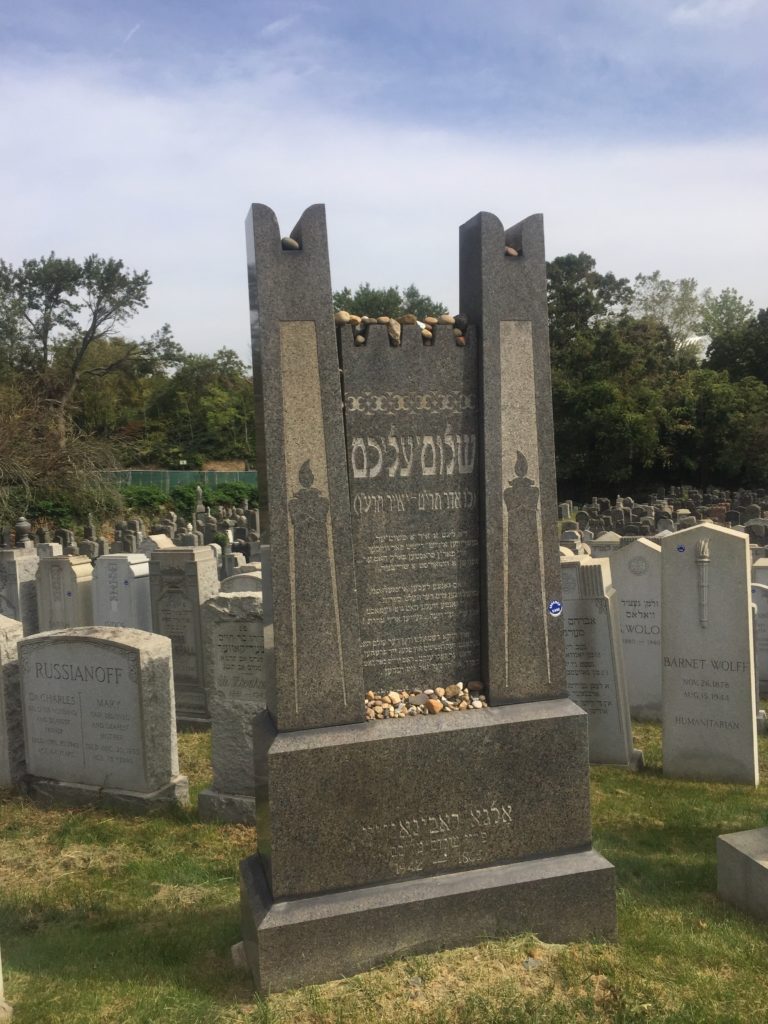Erik Visits an American Grave, Part 1,008
This is the grave of Sholem Aleichem.

Born in 1859 in what is today Ukraine, Solomon Rabinovich was part of a downwardly mobile family. His father had been a successful businessman, but had lost all his money on bad business deals. Then his mother died of cholera when he was a teenager. But the young Rabinovich was very into writing and this was supported the family. He started in an amusing way–collecting all the epithets that his grandmother, who evidently worked blue, used in the house. He adopted Sholem Aleichem as his pen name when he was only 15 years old. After graduating from high school, he taught a rich landowner’s daughter for a few years, who he then married against the wishes of her father. By this time, he was also serving as a crown rabbi, which was a term for those who mediated between the Jewish community and the Russian government. He was a bit like his father in that he became rich when his father-in-law died in the mid-1880s and then blew the whole estate in bad business deals that forced him on the run to escape his creditors. His mother-in-law basically took care of it eventually, but Aleichem was pretty poor until the mid-1890s.
Well, Aleichem slowly worked his way back up and that’s because he was a popular writer. By the 1880s, he was already making good money off his writing. By 1890, he was one of the most popular writers working in Yiddish, read throughout the Jewish diaspora. For awhile, he lived pretty well and rich enough to support other Yiddish writers while they tried to establish themselves, although again, he was not good with money and this cost him most of the next decade where he had to do real work instead of write fiction. His major works are among the most important in global literature of the time. Teyve the Dairyman is his most famous book, the basis for Fiddler on the Roof. This was a story of him supposedly meeting Teyve, who tells him about his life, his many daughters and their marriages, the Russian expulsion of Jews, and other key events in modern Yiddish life. He wrote heavily in Yiddish, Russian, and Hebrew. He was a translator of Tolstoy into Yiddish. His style was realism, providing descriptions of shtetl life that readers would recognize. He lectured around Europe, primarily to the continent’s many Jewish communities (if only that was still true) but not exclusively to them. Overall, he published about 40 books, including novels, stories, and essays. He was also one of the first people to write children’s stories in Yiddish, which I find interesting, not knowing really anything about this issue.
But what future was there for Jews under the Czar? The pogroms that followed the 1905 Revolution shook Aleichem to his core. He left Kiev that year and headed to New York. But his family didn’t want to go. His wife immigrated to Geneva and wouldn’t come to New York. So not able to support himself and his family in two different countries, he came back to Switzerland. He was politically active in support of Zionism and he saw Yiddish as the Jewish national language, not Hebrew. But he thought, correctly, that Yiddish was as fully-formed and important as French or German, the two languages for intellectuals of the day. As such, he pushed in a lot of his work an early form of Yiddish literary criticism, making the case that the greatest writers in the language were just as important as Flaubert or Dickens or other leading European writers of the day.
in 1914, Aleichem finally convinced most of his family to move to New York. His oldest daughter, now an adult, decided to stay in Geneva. This mattered a lot. That’s because the family had to pass the increasingly strict health requirements to enter the nation as the U.S. moved toward greater immigration restrictions. His son Misha was diagnosed with tuberculosis and not allowed to enter the country after going through the Ellis Island health exams. So Misha was put right back on the boat and sent back to Switzerland. Had his older sister not remained in Switzerland, I imagine the whole family would have had to return. In any case, how heartbreaking. Aleichem would never see his son again. In 1916, after only two years in the U.S., he died himself of tuberculosis. In fact, he surely had it before he got to the U.S. but was able to get around the medical exam when he son did not. He was 57 years old. He was still working on his last novel, Motl, Peysi the Cantor’s Son, which told the story of a Jewish immigrant both in Europe and in New York. He was a big enough deal globally that his entire will was printed in the New York Times and his funeral drew 100,000 people.
Sholem Aleichem is buried in Mount Carmel Cemetery, Queens, New York.
If you would like this series to visit other Jewish writers, you can donate to cover the required expenses here. Chaim Potok is in Huntingdon Valley, Pennsylvania and Isaac Bashevis Singer is in Paramus, New Jersey. Previous posts in this series are archived here.


